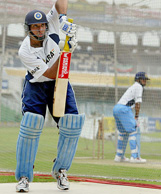ARTICLES
The Art of Batting - II
- By Polly UmrigarTHE STANCE - POSITION
Watching down the pitch from the bowlers end, the batsman's toe should be just about in line with the leg stump. Some batsmen rest their bat behind the right toe. This encourages straighter back lift and sounder for defense play. The left shoulder should be pointing down the pitch or very nearly so with the head turned so that both eyes are clearly focused on the bowler The batsman should try and be relaxed and comfortable.[ E ] BACK LIFT
Many coaches teach their pupils the necessity of taking one's bat back perfectly straight. But actually, many players fail because their thoughts are concentrated on where their elbow is or where the bat is instead of playing the ball. The player who uses the crease area and takes the bat backwards absolutely straight would find himself out hit wicket.So long as the batsman is in the right position at the time of playing the ball, I do not think any thing can go wrong, even if his bat comes down from the first slip.
Whether the bat is taken back straight towards the stumps or towards first slip, one should ensure that it is not too high. The backlift should be no higher than is necessary for a proper balance between control in defence and power in attack.
Some coaches teach right-handed batsmen players to take the bat back with the left hand. Due to this a defensive complex starts to build up. The right hand should also predominate sometimes - in the pull shot for instance, and the left hand, especially in defence.
[ F ] FOOTWORK
What is meant by the term' footwork'?The answer - Movement of the feet, so as to be in the right position with plenty of time to spare. Footwork should have a requisite speed and should be coordinated with perfect judgment.
Footwork is certainly one of the keys to batsmanship; it is to batting what foundation is to a house. Without it, there can be no structure.
[ G ] BACKWARD DEFENCE
When playing back defensively, the bat in its downward path should pass just outside the right pad as it comes forward to meet the ball.
VVS Laxman executes
the backward defensive
shot in the nets.
Coinciding with the initial movement of taking the
bat back, the right foot must be moved back and
across in front of the stumps. The left foot should
be automatically brought across so that the stumps
are completely protected.
The toe of the right foot should point towards the extra cover or mid-off region. The full weight of the body should be taken on the right foot. 'The right hand slides down to the bottom of the handle, to give added Control. Try to play the ball towards the bowler or mid-on rather than towards cover. For a rising ball, the right hand should be left loose.
Keep the head well over the line of flight and down. Lifting the head is fatal and generally results in cocking the ball up or hitting it on the edge.
Both the backward and forward defence should be practised in front of a mirror.
The toe of the right foot should point towards the extra cover or mid-off region. The full weight of the body should be taken on the right foot. 'The right hand slides down to the bottom of the handle, to give added Control. Try to play the ball towards the bowler or mid-on rather than towards cover. For a rising ball, the right hand should be left loose.
Keep the head well over the line of flight and down. Lifting the head is fatal and generally results in cocking the ball up or hitting it on the edge.
Both the backward and forward defence should be practised in front of a mirror.
[ H ] FORWARD DEFENCE
This type of defensive stroke should be used when the ball is pitched farther up than a good length. There is not much of a backlift and the bat has to be kept absolutely perpendicular. The handle of the bat should be kept forward of the blade in order to keep the ball down. The batsman should always play close to the front leg, so that the ball cannot get between bat and pad. The left shoulder and elbow should lean forward towards the pitch of the ball and drag the front foot and body forward. The left knee should be bent slightly to hold the weight of the body in balance and the left toe should be pointed towards cover, mid-off or the bowler, varying it according to the direction of the ball. Keep the head well forward and down. The right toe must be kept firmly behind the batting crease to avoid being stumped. In forward defence, the left hand is in control, the right hand grip becomes a thumb and first two fingers should be placed at the bottom of the handle. The left hand should be over the handle. The left hand at the back of the handle curbs any tendency to follow through.[ I ] LATE CUT
When a slow bowler is operating and is giving the ball a reasonable amount of air by tossing it up, he is naturally doing this to try to get more turn on the ball. The batsman's job is to counter this idea and one of the best ways in which to do this is to use the feet and go down the wicket to attack the bowling, either hitting it on the half volley or full toss to prevent the spin from taking effect.To be continued... The Art Of batting - III